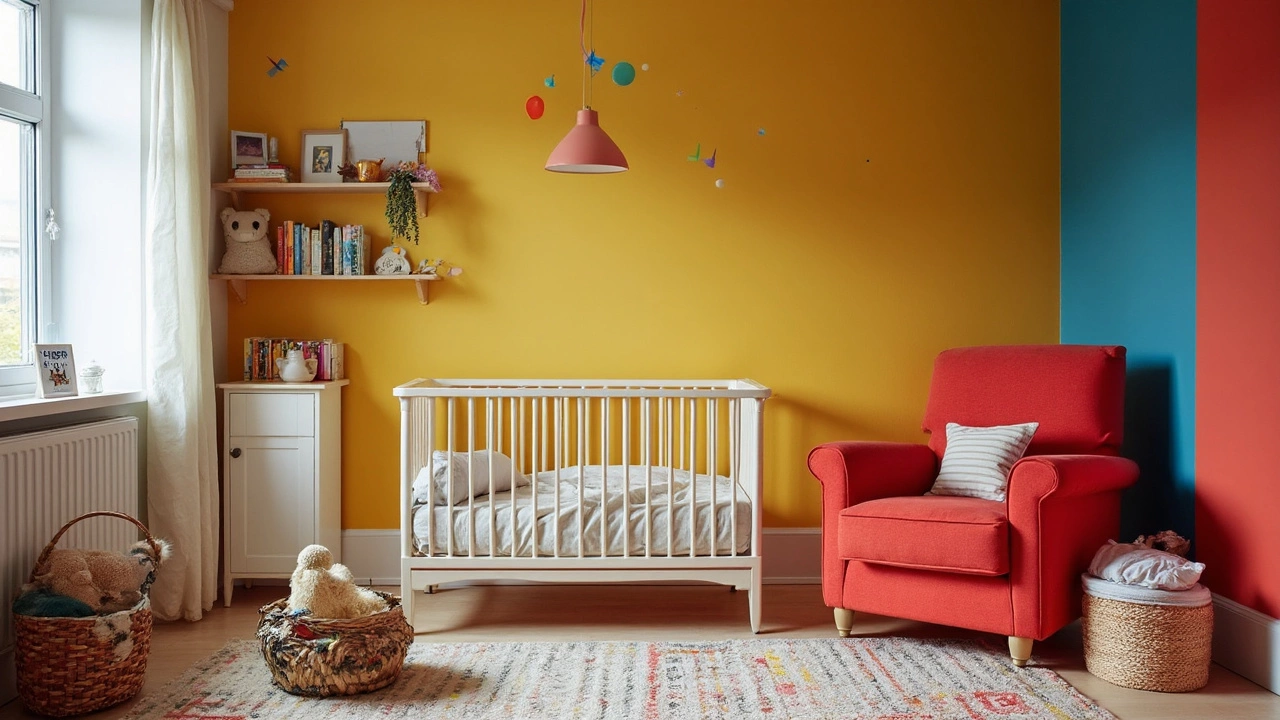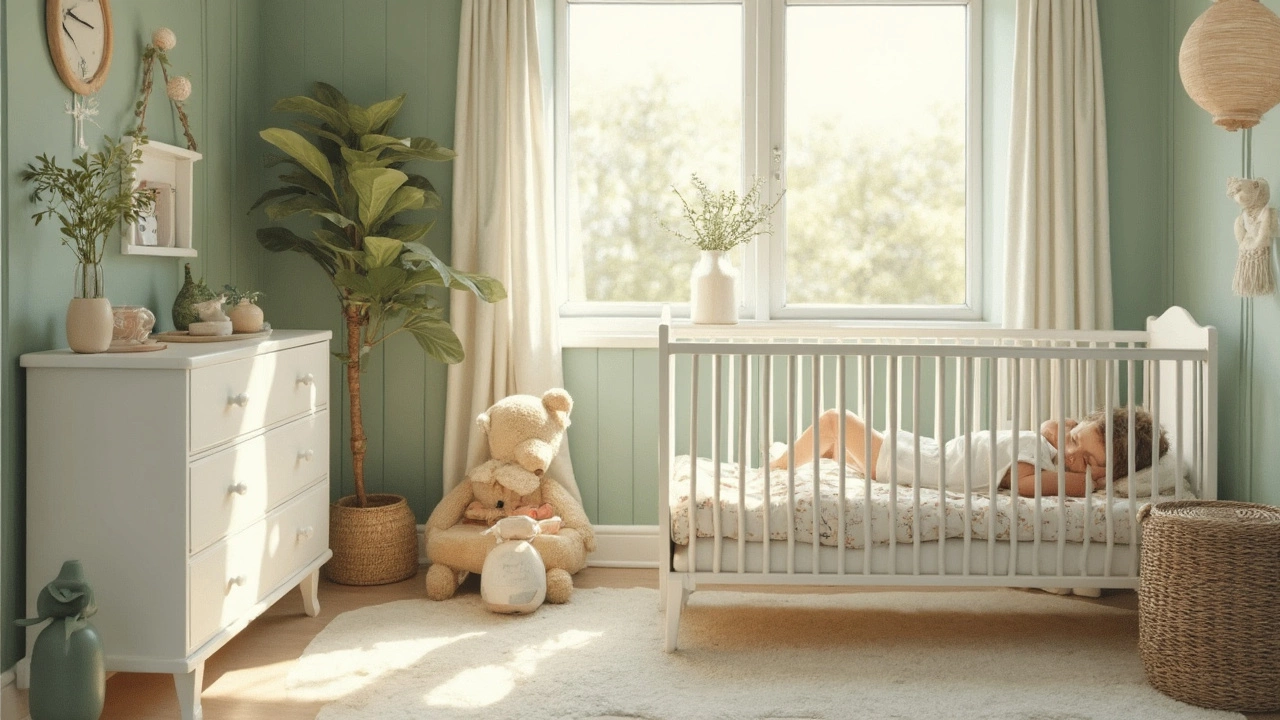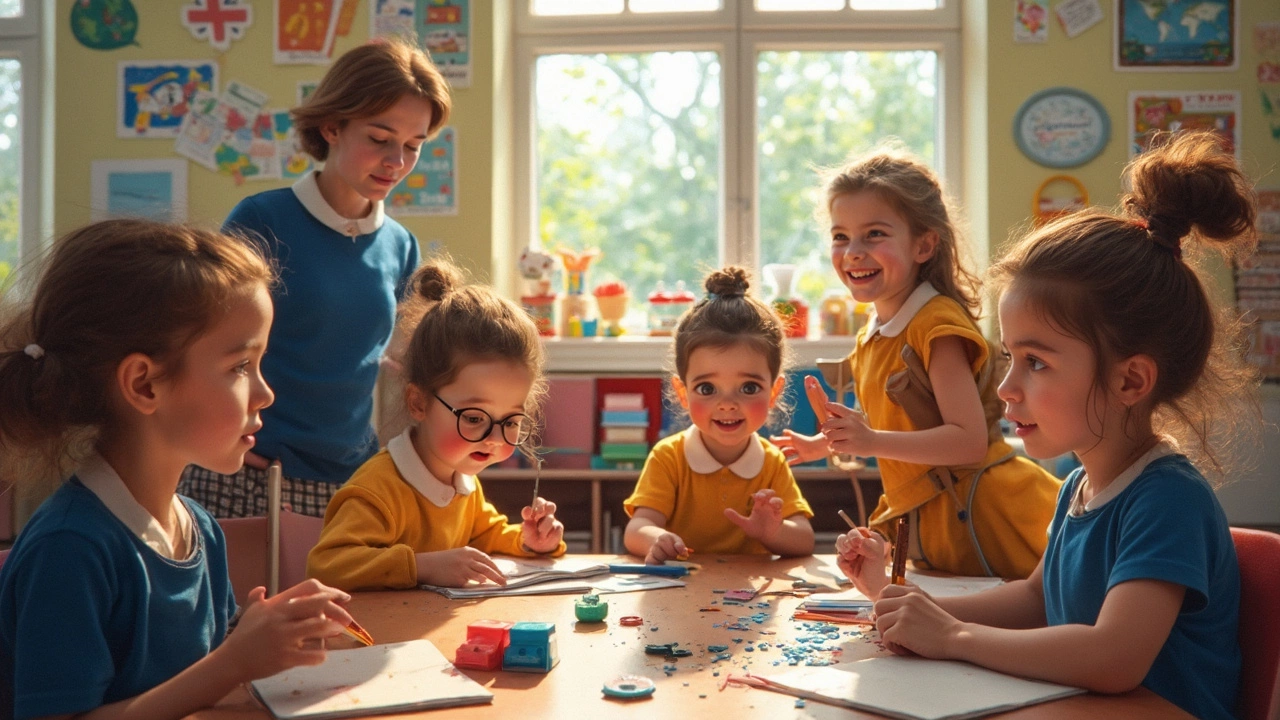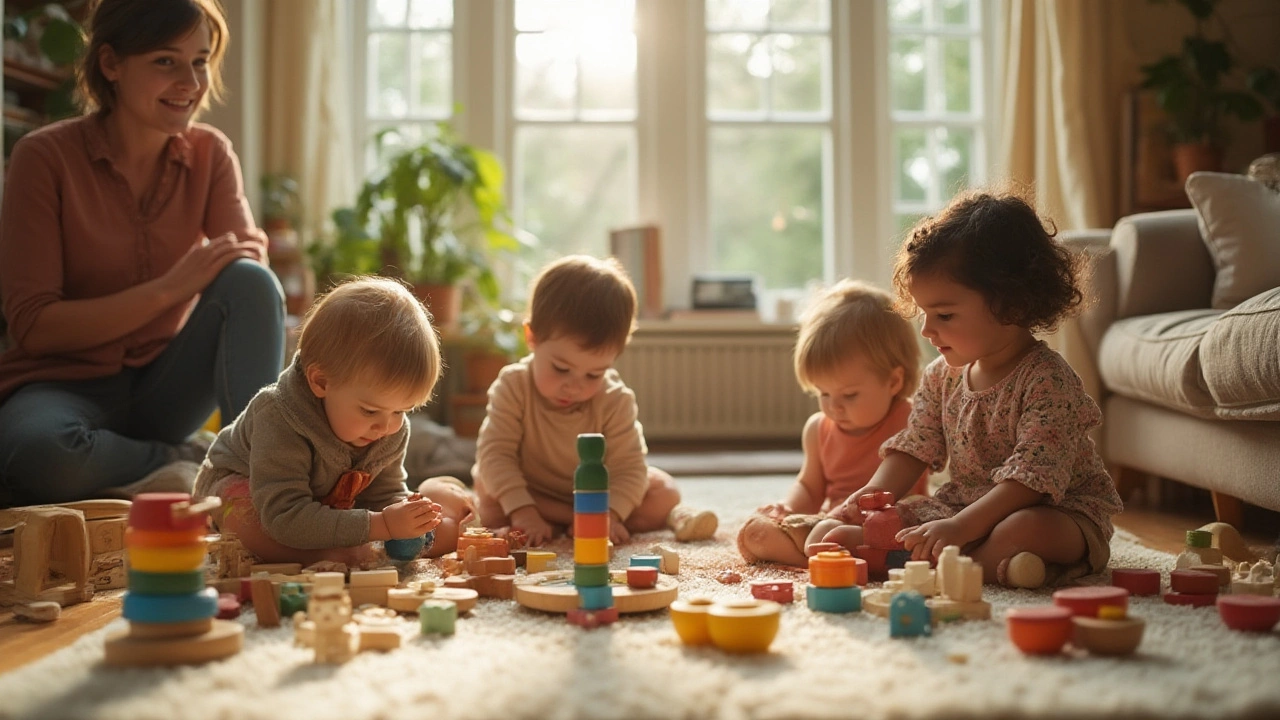Nursery Colors to Avoid: How Paint Choices Shape Baby's Mood and Sleep

Color makes a bigger difference than you think when you’re putting together a nursery. That playful bright paint you saw online might look cool at first glance, but it could actually leave your baby tossing and turning—or even trigger pretty epic meltdowns. Turns out, babies are way more sensitive to color than adults. Some shades can hype them up, make them cranky, or just mess with their natural routines.
Here’s the thing: certain colors are proven to stimulate the brain, while others set the stage for calm and better sleep. You don’t need an interior design degree to get this right. Just knowing which colors to avoid—and why—will help you create a room where your little one (and you) finally get some rest. Let’s be real: you want a nursery that feels peaceful, not like a circus in a can of paint.
- Why Nursery Color Matters
- Red Flags: The Colors That Disrupt Sleep
- Overstimulating Shades: What to Steer Clear Of
- Colors Linked to Mood Swings or Restlessness
- Clashing with Nursery Furniture: Style Risks
- What Works Better: Softer Alternatives That Soothe
Why Nursery Color Matters
Picking the right color for your nursery is way more than just an Instagram aesthetic. Science backs this up: the shades you splash on those walls actually impact your baby’s sleep, mood, and even early development. The big deal here is that babies process their environment through senses—with vision being a major one once they’re a few months old. Certain colors in a nursery can either calm your little one or leave them feeling wired and unsettled.
Think about nap time. Research from pediatric sleep experts shows that rooms painted in softer, muted tones help regulate a baby’s sleep cycle, while vibrant or harsh colors (like bold reds) raise heart rates and make sleep harder. Ever tried unwinding in a bright orange room? Babies feel that times ten! Pick the wrong nursery colors, and you might accidentally create a battleground instead of a restful escape.
Color isn’t just about emotional vibes, though. Babies are still getting used to their eyesight, and colors like very dark blue, black, or deep gray can feel confining, even scary, for some kids. Also, the light bouncing off your nursery furniture will look different depending on your wall color, which can affect how the space feels overall.
Here’s a quick glance at how colors are linked to mood and sleep, especially in nurseries:
| Color | Common Effect on Babies |
|---|---|
| Red | Stimulates, can increase crying or restlessness |
| Bright Yellow | Overstimulating, may disturb sleep |
| Dark Blue or Black | Can feel too gloomy or confining |
| Soft Green or Blue | Usually calming, helps with relaxation |
| Pale Neutrals | Safe, soothing, flexible for décor |
Bottom line: picking nursery paint is about way more than looks. Your choices set the tone for comfort, sleep, and those all-important first memories. So, when you plan your baby room, color is not a small thing—it's shaping your baby's world from day one.
Red Flags: The Colors That Disrupt Sleep
Not every color belongs in a nursery—especially if you want your little one (and yourself) to get some decent sleep. Some colors are notorious for cranking up energy and making winding down at bedtime way harder than it needs to be. Let’s break down which ones you absolutely want to skip for your baby’s room.
- Red: Studies show that bright red can actually raise heart rate and boost adrenaline, which is the exact opposite of what you want when you’re trying to get a baby to sleep. It’s just too ‘loud’ for a restful space.
- Orange: While orange might seem cheerful, it’s another super-energizing color. Babies (and adults) can feel more alert or even fussy if there’s too much orange in their environment.
- Bright Yellow: Yellow can feel sunny and warm, but too much of it, especially in a strong or neon shade, is shown to make babies cranky and overstimulated. Ever been in a room that feels “tense” for no reason? It could be the yellow.
One study published by the University of British Columbia in 2023 found that babies slept up to 30 minutes less per night in brightly colored rooms versus pastel or neutral colored rooms. That half hour adds up by the end of a week!
“Colors like bright red or orange are stimulating to the brain and nervous system, which can make falling asleep more difficult for young children.” —Dr. Sophie Bremner, child psychologist
If your nursery colors lean toward the bold side, it might be worth a rethink. Stick to softer tones and you’ll help make naps and bedtimes a little easier on everyone.
Overstimulating Shades: What to Steer Clear Of
Some nursery colors are just too much for a baby’s eyes and brain. Bright red, electric orange, and super bold yellows can easily overdo it. Babies don’t need a rainbow rave; in fact, these loud shades can make them restless and fire up their energy when you’d rather see them nap.
Studies from pediatric sleep clinics show that colors to avoid like fire engine red or bright fuchsia actually boost heart rates and make it harder for infants to settle down. Neon green is another offender—yes, it looks energetic, but babies get agitated fast in rooms full of flashy colors. Some experts say colors like these cause stress hormones to rise, messing up the calm mood you want in a baby room.
- Bright red: Linked to overstimulation and even increased crying in newborns.
- Vivid orange: Kids might like orange toys, but walls in this color can keep children too alert for bedtime.
- Neon yellow: On large surfaces, this shade is known to cause eye fatigue and fussiness.
- Purple and blue that are too intense: Deep, electric versions can feel cold and jarring, while lighter ones tend to soothe.
If you still want pops of color, try using those energetic shades in small doses—maybe a throw pillow or a toy bin—rather than coating the walls. Here’s a quick rundown on how these overstimulating shades stack up, according to child development research:
| Shade | Effect on Children |
|---|---|
| Bright Red | Increases alertness, can trigger anxiety |
| Electric Orange | Keeps children alert, hard to relax |
| Neon Yellow | Eye strain, higher levels of fussiness |
| Neon Green | Disrupts sleep, more stimulation |
The main thing to remember: keep most of the nursery palette soft and gentle. Save loud, playful shades for small accessories. You’ll have a much calmer, happier space that’s a lot easier on your baby’s eyes—and your nerves too.

Colors Linked to Mood Swings or Restlessness
Not all colors create a peaceful vibe in your baby's room. Some tones actually mess with your little one's mood and can make them more restless than relaxed. It's not just a parenting myth—science backs this up. Certain nursery colors are connected to emotional swings in young kids, and most experts say it's smart to steer clear of them for your peace of mind.
Bright yellows might seem cheerful, but research suggests they can be too energizing for sleep spaces. A study published in the journal Color Research & Application found that rooms dominated by strong yellow shades led to "higher levels of crying and fussiness in infants." Then there's pure white—while it does look clean, it can feel clinical and even cold, which isn’t great for a cozy nursery. The same goes for super-bright greens and oranges. These colors are common in preschool playrooms for a reason—they keep kids active. But in a sleep space, they can overstimulate.
Dr. Amy Talbott, a child psychologist, notes:
“Children are quick to react to their setting. Colors like vivid red, orange, and neon green can make it harder for them to wind down.”
If you’re weighing paint swatches for a baby room, here are a few shades proven to spark mood changes and sometimes make babies fidgety:
- Bright red: Raises excitement and can boost heart rate. Not what you want at naptime.
- Deep purple: Looks cool, but can feel heavy and overwhelming for tiny humans.
- Electric blue: Feels intense, sometimes causing agitation instead of calm.
- Vivid yellow: As mentioned, linked to restlessness and fussiness.
Check out these stats researchers have noticed about nursery color choices and baby temperament:
| Color | Effect | Recommendation |
|---|---|---|
| Bright red | Increases crying & activity | Avoid |
| Lime green | May cause agitation | Avoid |
| Neon yellow | Can upset sleep | Avoid |
Bottom line: if you’re aiming for a calm and restful space, skip the loud or super-saturated colors. Save those pops of brightness for toys or wall art, not the whole room. Your baby's mood—and your own sanity—will thank you.
Clashing with Nursery Furniture: Style Risks
Matching wall colors with your nursery furniture is more important than most people realize. When the paint shade totally clashes with the crib, rocker, or dresser, the whole room feels thrown together—even if each piece is beautiful on its own. For example, pairing super bright orange walls with dark wood cribs can make the room feel cramped and overwhelming, not cozy. That bold color pulls attention away from the furniture and creates a vibe that just feels “off.”
Glossy white or ultra-modern furniture can also struggle against deep purples, reds, or navy blues. These dark shades often shrink the visual space and make your expensive nursery furniture look stark or even out of place. If you’re working with a lot of pastel furniture—think light woods or soft whites—then harsh neon or primary colors compete for attention and sort of drown out everything else in the room.
Here’s a quick look at common clashes parents run into:
- Vivid green or teal walls next to oak or pine cribs—a no-go. It looks busy and unsettled.
- Bright yellows with gray or blue furniture can give off a jarring, mismatch-from-another-planet vibe.
- Red walls next to almost any kind of wood furniture often look harsh and can make both the walls and furniture look cheap.
Style trends always shift, but clashing colors with furniture can hurt both resale value and your daily mood. Designers often recommend sticking to neutral walls—think soft beige, warm white, or even muted sage—and then letting your nursery furniture stand out. Neutral doesn’t mean boring: you can always use colorful wall art, rugs, or bedding to add personality without overwhelming the eye.
If you love color but want a more pulled-together look, try matching wall colors to a detail in your furniture (like a wood grain or drawer handle shade). A quick hack: check paint samples next to your furniture in natural light. You’d be surprised how many bold colors look totally different in the actual room. This step saves time, money, and headaches down the road.
What Works Better: Softer Alternatives That Soothe
If you want your nursery to feel like a chill haven instead of a battleground, softer colors are your best friends. Research from places like the National Sleep Foundation says that light blues, pale greens, and gentle lavenders actually help babies (and parents) relax. These shades are top picks when you're thinking about nursery colors because they keep things calm without being boring.
So, why do these colors work so well? Soft hues literally lower your heart rate and help with falling asleep faster. Hospitals and daycares often pick sky blue or muted green walls for a reason. Babies' vision is still developing, and these shades don't overwhelm their senses—plus, they’re super easy to pair with any nursery furniture.
Here’s a quick breakdown of solid color choices that actually support sleep and happy moods:
- Light Blue: Known to slow heart rate and lower blood pressure. That’s why it’s used in tons of pediatric clinics.
- Soft Green: Reminds your brain of nature and growth. Even paint companies highlight sage and mint as great nursery picks.
- Lilac or Light Lavender: Gentle on the eyes and often linked to peaceful vibes.
- Warm Beige and Taupe: These earth tones warm the space up without getting too dark or gloomy.
- Muted Yellows: Think buttercream or pastel. Too-bright yellow can hype babies up, but a creamy yellow makes a space feel sunny without being overwhelming.
You can keep it from looking flat by adding different textures—like a woven rug, cozy blankets, or a patterned curtain—so those soft shades won’t feel dull. And with these colors, your nursery furniture pops in a subtle, stylish way.
| Color | Effect on Babies | Pairs Well With |
|---|---|---|
| Light Blue | Calm, helps with sleep | White or gray cribs, wooden shelves |
| Soft Green | Balanced mood | Natural wood, beige upholstery |
| Light Lavender | Reduces stress | White dressers, pastel bedding |
| Muted Yellow | Cozy, cheery | White or light gray storage units |
Bottom line: Stick with colors that help your baby feel safe and settled. That way, your nursery will actually support better sleep and smoother days—for everyone.

